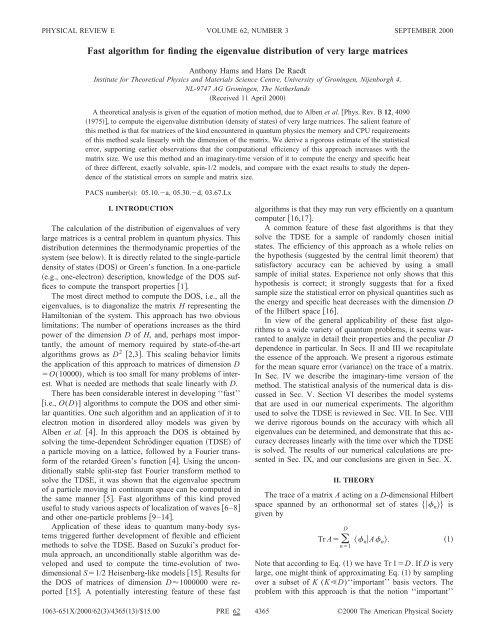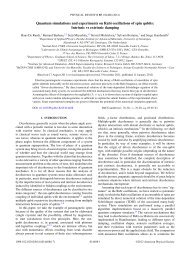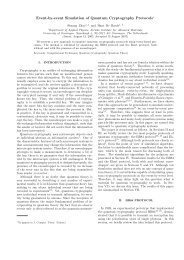Fast algorithm for finding the eigenvalue distribution of very large ...
Fast algorithm for finding the eigenvalue distribution of very large ...
Fast algorithm for finding the eigenvalue distribution of very large ...
Create successful ePaper yourself
Turn your PDF publications into a flip-book with our unique Google optimized e-Paper software.
PRE 62 4371FAST ALGORITHM FOR FINDING THE EIGENVALUE ...FIG. 3. Energy top and specific heat bottom <strong>of</strong> <strong>the</strong> XY model see Eq. 39, with 1 and h0. Left: L6; middle: L10; right:L15. Solid lines: exact result; crosses: simulation data using S5 samples; squares: simulation data using S20 samples. Error bars: Onestandard deviation.exact results and, equally important, <strong>the</strong> estimate <strong>for</strong> <strong>the</strong> errorcaptures <strong>the</strong> deviation from <strong>the</strong> exact result <strong>very</strong> well. Wealso see that in general <strong>the</strong> error decreases with <strong>the</strong> systemsize. Both <strong>the</strong> imaginary- and real-time methods seem towork <strong>very</strong> well, yielding accurate results <strong>for</strong> <strong>the</strong> energy andspecific heat <strong>of</strong> quantum spin systems with modest amounts<strong>of</strong> computational ef<strong>for</strong>t.X. CONCLUSIONSThe <strong>the</strong>oretical analysis presented in this paper gives asolid justification <strong>of</strong> <strong>the</strong> remarkable efficiency <strong>of</strong> <strong>the</strong> realtimeequation-<strong>of</strong>-motion method <strong>for</strong> computing <strong>the</strong> <strong>distribution</strong><strong>of</strong> all <strong>eigenvalue</strong>s <strong>of</strong> <strong>very</strong> <strong>large</strong> matrices. The real-timemethod can be used whenever <strong>the</strong> more conventional,Lanczos-like, sparse-matrix techniques can be applied:Memory and CPU requirements <strong>for</strong> each iteration time-stepare roughly <strong>the</strong> same depending on <strong>the</strong> actual implementation<strong>for</strong> both approaches.We do not recommend using <strong>the</strong> real-time method if oneis interested in <strong>the</strong> smallest or <strong>large</strong>st <strong>eigenvalue</strong> only.Then <strong>the</strong> Lanczos method is computationally more efficientbecause it needs less iterations time steps than <strong>the</strong> real-timeapproach. However, if one needs in<strong>for</strong>mation about all ei-FIG. 4. Energy top and specific heat bottom <strong>of</strong> <strong>the</strong> Ising model in a transverse field see Eq. 39 with 0 and h0.75J. Left:L6; middle: L10; right: L15. Solid lines; exact result; crosses: simulation data using S5 samples; squares: simulation data usingS20 samples. Error bars: one standard deviation.
PRE 62 4375FAST ALGORITHM FOR FINDING THE EIGENVALUE ...PX I 2XI 2D2 1XI 2D 1D11X D2 X 1X.The moments E(c 2M ) are given byA21Ec 2M X M PXdX1D1 X M 1X D2 dX D1M ,0 DM A22and <strong>the</strong> values <strong>of</strong> interest to us areEc 0 1, Ec 2 1 D , 2Ec4 DD1 , A23where <strong>the</strong> first two results provide some check on <strong>the</strong> procedureused. Substituting Eq. A23 into Eq. A14 yieldsETr RA 2 D Tr A† ATr A 2. A24SD1APPENDIX B: ERROR BOUNDSHere we prove that <strong>the</strong> difference between <strong>the</strong> <strong>eigenvalue</strong>s<strong>of</strong> <strong>the</strong> Hermitian matrix AB and those obtained from<strong>the</strong> approximate time-evolution exp(zA/2)exp(zB)exp(zA/2)(zi,) is bounded by 2 . In <strong>the</strong> following we assumeA and B are Hermitian matrices and take , a real, nonnegativenumber. We start with <strong>the</strong> imaginary-time case.We define <strong>the</strong> difference R() byRe (AB) e A/2 e B e A/2 1 40d 0d 0de A/2 e B e B †2B,A,B‡e Be A/2 †A,A,B‡e A/2 e A/2 e ()(AB) ,a well-known result 24. We have 26B1R4 1 d0 d0 ()(AB)de A/2 e ()B †2B,A,B‡e B e A/2 e0 1 4 d0 d0 ()(AB)de A/2 e B e A/2 †A,A,B‡e ()A/2 e0 1 4 d0 d0 de A/2 e ()B †2B,A,B‡ B e A/2 e ()(AB)0 1 4 d0 d0 de A/2 e B e A/2 †A,A,B‡e ()A/2 e ()(AB)0 1 24 3 e (AB) †A,A,B‡†2B,A,B‡,B2andR4 1 d0 d0 ()(AB)de A/2 e ()B †2B,A,B‡e B e A/2 e04 1 d0 d0 ()(AB)de A/2 e B e A/2 †A,A,B‡e ()A/2 e0 1 4 d0 d0 ()(AB)de A/2 e ()B †2B,A,B‡e B e A/2 e04 1 d0 d0 ()(AB)de A/2 e B e A/2 †A,A,B‡e ()A/2 e0 1 40d 0d 0de A/2 e ()B †2B,A,B‡e B e A/2 e ()(AB) 1 40d 0d 0de A/2 e B e A/2 †A,A,B‡e ()A/2 e ()(AB) 1 24 3 e (AB) †A,A,B‡†2B,A,B‡.B3
PRE 62 4377FAST ALGORITHM FOR FINDING THE EIGENVALUE ...implyingx j 0y j s2 2 . B22In summary, we have shown that in <strong>the</strong> real-time case <strong>the</strong>reexists a permutation <strong>of</strong> <strong>the</strong> approximate <strong>eigenvalue</strong>s suchthat <strong>the</strong> difference with <strong>the</strong> exact ones vanishes as 2 .Finally we note that both upper bounds B22 and B14hold <strong>for</strong> arbitrary Hermitian matrices A and B and are <strong>the</strong>re<strong>for</strong>era<strong>the</strong>r weak. Except <strong>for</strong> <strong>the</strong> fact that <strong>the</strong>y provide asound <strong>the</strong>oretical justification <strong>for</strong> <strong>the</strong> real- and imaginarytime method, <strong>the</strong>y are <strong>of</strong> little practical value.1 G. D. Mahan, Many-Particle Physics Plenum Press, NewYork, 1981.2 J. H. Wilkinson, The Algebraic Eigenvalue Problem ClarendonPress, Ox<strong>for</strong>d, 1965.3 G. H. Golub and C. F. Van Loan, Matrix Computations JohnHopkins University Press, Baltimore, MD, 1983.4 R. Alben, M. Blume, H. Krakauer, and L. Schwartz, Phys.Rev. B 12, 4090 1975.5 M. D. Feit, J. A. Fleck, and A. Steiger, J. Comput. Phys. 47,412 1982.6 H. De Raedt and P. de Vries, Z. Phys. B: Condens. Matter 77,243 1989.7 T. Kawarabayashi and T. Ohtsuki, Phys. Rev. B 53, 69751996.8 T. Ohtsuki and T. Kawarabayashi, J. Phys. Soc. Jpn. 66, 3141997.9 T. Iitaka, S. Nomura, H. Hirayama, X. Zhao, Y. Aoyagi, andT. Sugano, Phys. Rev. E 56, 1222 1997.10 S. Nomura, T. Iitaka, X. Zhao, T. Sugano, and Y. Aoyagi,Phys. Rev. B 56, 4348 1997.11 S. Nomura, T. Iitaka, X. Zhao, T. Sugano, and Y. Aoyagi,Phys. Rev. B 59, 10 309 1999.12 T. Iitaka and T. Ebisuzaki, Phys. Rev. E 60, 1178 1999.13 T. Iitaka and T. Ebisuzaki, Microelectron. Eng. 47, 321 1999.14 T. Iitaka and T. Ebisuzaki, Phys. Rev. E 61, 3314 2000.15 P. de Vries and H. De Raedt, Phys. Rev. B 47, 7929 1993.16 H. De Raedt, A. Hams, K. Michielsen, S. Miyashita, and K.Saito, Prog. Theor. Phys. 138, 489 2000.17 D. S. Abrams and S. Lloyd, Phys. Rev. Lett. 83, 5162 1999.18 G. R. Grimmet and D. R. Stirzaker, Probability and RandomProcesses Clarendon, Ox<strong>for</strong>d, 1992.19 E. Lieb, T. Schultz, and D. C. Mattis, Ann. Phys. N.Y. 16,407 1961.20 H. De Raedt, Comput. Phys. Rep. 7, 11987.21 M. Suzuki, S. Miyashita, and A. Kuroda, Prog. Theor. Phys.58, 1377 1977.22 X denotes <strong>the</strong> spectral norm <strong>of</strong> <strong>the</strong> matrix X; see The AlgebraicEigenvalue Problem Ref. 2 and Matrix ComputationsRef. 3.23 H. De Raedt and B. De Raedt, Phys. Rev. A 28, 3575 1983.24 M. Suzuki, J. Math. Phys. 26, 601 1985.25 H. De Raedt and K. Michielsen, Comput. Phys. 8, 600 1994.26 M. Suzuki, J. Math. Phys. 61, 3015 1995.27 A. J. H<strong>of</strong>fman and H. W. Wielandt, Duke Math. J. 20, 371953.






